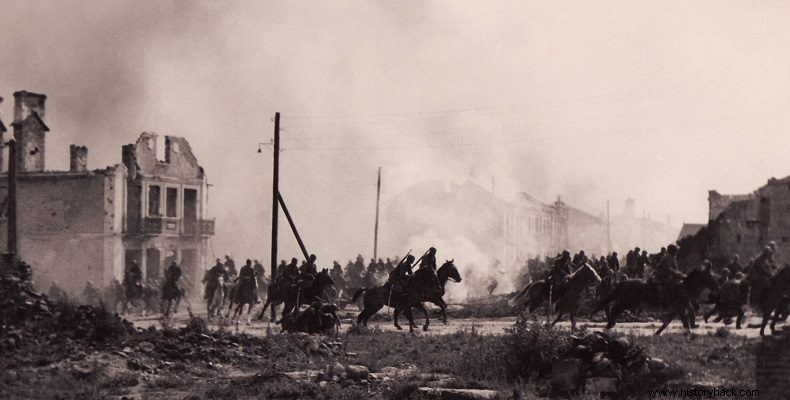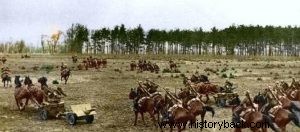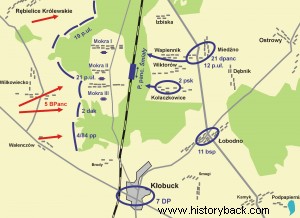
On September 1, 1939, Hitler's armies invaded Poland, triggering the outbreak of the great carnage of World War II. Based on the plans of the Polish High Command, the Army of Poznań, the Army of Loch and the Army of Kraków were deployed on the western border of Poland. Lotz's Army had as its main role the link between the two other armies, but also the cover under formation of the "Prussian" reserve Army.
The Cavalry Brigade (TI) of Volhynia under Colonel Julian Filipovich also belonged to the Lotz Army. TI had the 19th Ulan Regiment (spearmen), the 21st Ulan Regiment (SO), the 12th SO and the 2nd Mounted Rifle Regiment (SET) .
He also commanded the 21st Hepilarchy light tanks and the 4/84 Infantry Battalion , an artillery squadron, an anti-aircraft gunnery, a cyclist platoon, an engineer platoon, a relay platoon, a heavy machine gun platoon, a regiment and services.
Each Cavalry Regiment (CI) had four mounted companies, one machine gun company (12 machine guns), 12 anti-tank rifles and four anti-tank guns. Each cavalry regiment corresponded to an infantry battalion. In total the TI had 16 75mm guns, two 40mm anti-aircraft guns and 18 37mm anti-tank guns. Its command had 13 tankettes (light tanks) TKS ТК-3 and eight armored vehicles wz.34 or wz.39. In total a TI of four SIs extended about 7,200 men.
Layout
On that fateful 1 September the Brigade had been ordered to deploy to the Mokra area, 80 km north of Katowice. Its commander deployed the 19th, 21st SO and 4/84th Battalion to Mokra Forest. Colonel Filipovich kept in reserve the 12th SO and the 2nd SET as well as the 21st Division.
The Brigade's mission was to be the link between the 7th and 30th Infantry Divisions (IP). The terrain chosen by Filipovic was ideal for defense. The spur of the railway line that ran through the area, the forest, the hills and the many streams made for an excellent defensive location.
On the opposite side of the hill, the Germans had General Hepner's XVI Army Corps, with the 1st and 4th Panzer Divisions (MPa) and the 31st MP. The 4th BA acted against the Brigade The Corps belonged to the 10th Army. At 05.00 in the morning the Germans invaded. By forcing the Polish advance forces to retreat, the Germans found themselves in front of the Brigade's defensive location.
The Germans invade
The Germans moved on three axes. The 1st Infantry Division attacked the Polish 7th Infantry Division while the 4th Infantry Division formed two attack phalanxes and attacked the location of Mokra. At the same time the Luftwaffe began bombing the Poles. By the end of the day the German air force had carried out 15 attacks with equal waves of 9 – 26 Stuka aircraft each time.
At 06.30 German motorcyclists made contact with the Polish defensive position coming face to face with the 12th Company of the 4/84 Battalion under Captain Radajewicz. Immediately after, the Germans threw tanks into the battle. According to the Poles, they even used civilians as human shields.
However, flanking fire by the defending Poles caused confusion among the Germans, which the civilians took advantage of and crossed into the Polish lines. The Germans soon resumed the attack but suffered heavy casualties from the Polish machine guns and many motorcyclists were captured.
Having failed against the infantry, the 4th Infantry Division tried its luck against the 21st SO . After a short artillery preparation and aerial bombardment, the German tanks captured the village of Vilikowiesk and moved directly towards the village of Mokra. The 21st SO had losses mainly in horses, from the bombardment and so when the Germans reached a distance of 150m. from his positions they received a particularly warm reception.
Two German tanks were shaken in the air and the rest retreated 400m. back. The German infantry that accompanied them was thus left unaccompanied and suffered heavy losses, while with a successful counterattack the Poles also captured prisoners.
The Germans, around 08.00, also attacked the 19th SO with a battle group that included tanks, armored, motorcyclists and infantry. The aim of the Germans was to overrun the positions of the 21st AF from the north. Thus they fell upon the 19th SO and suffered mortal losses. A German detachment was wiped out to one. But the Germans intensified their pressure on the Polish right and Colonel Filipowicz ordered the 12th SO to extend its defensive line to the north, supporting the flank of the 19th SO.
The Germans persist
At 10.00 the Germans attacked again. But they were repulsed, although they caused losses to the defenders. At 10.15 the 4th BA carried out a new attack with its divisions supported by artillery and aviation. The Germans attacked the 19th SO, the 21st SO at Mokra and the 4/84th Battalion. In the sector of Mokra they even threw about 100 tanks and armored vehicles into the battle.
To the north the Germans managed to penetrate the forest creating a breach between the 19th and 21st SO. The 19th century has almost come full circle. The situation was saved by the arrival of the Polish armored train No. 53 which, moving on the railway line, opened direct fire against the German tanks with its two 75mm guns. The German Pz I and Pz II light tanks retreated with heavy losses while the 19th SO managed to slip away.
And in the Mokra sector the German tanks forced the 21st SO to retreat. The same thing happened in the sector of the 4/84 Battalion. It seemed that the Poles were losing the battle. But again the intervention of the armored train saved the situation by striking against the panzers.
Polish counterattack
In the meantime, Filipovic had also called his 21st Division to support the center of his formation. Polish light tanks and vehicles attacked, under Major Glinski, supported by Captain Holak's cavalry. The Poles moved into the middle of the German tank phalanx causing confusion, despite the fact that their tanks were equipped with only one machine gun each.
The Poles broke through the German phalanx in an attack later dubbed a heroic cavalry charge. Actually the Polish horsemen never advanced. Throughout the battle they fought on foot. Due to the confusion the Germans retreated with losses.
At the same time Filipovic sent the 2nd SET, his last reserve, to support the 4/84th Battalion which had also been forced to retreat. The 2nd SET successfully fought back. By noon the Germans had retreated all along the Brigade's front. But at 12.15 they came back against Mokra with about 100 tanks, breaking through the lines of the 4th Infantry of the 21st SO, destroying two Polish anti-tank guns.
The 21st SO managed to retreat in order. The Germans then turned on the 12th SO and the Brigade's artillery squadron. The squadron lost five guns, but destroyed 13 German tanks in a few minutes. This fact was exploited by the 12th SO which maneuvered on the side of the Germans forcing them to retreat.
New attack
At 15.00 the stubborn Germans attacked again under the cover of their artillery throwing 180 tanks and armored vehicles into the battle. The brunt of the attack was borne by the 2nd IL of the 12th SO who fought truly heroically. The 4th Ili tried to counterattack but eventually both isles were forced to retreat.
It was the time of crisis. Filipovich no longer had any reserves and the situation looked hopeless. He then made the absurd decision to support his right flank with the 2nd SET that had been fighting on his left until then. Along with the 2nd SET, the 21st Division also attacked. The Polish counterattack was initially successful. But soon the Poles were attacked by overwhelmingly stronger German forces and retreated to the railway line.
But salvation awaited them there. Another armored train had arrived and together with the one already there they began to attack the Germans causing panic. The German charioteers went so far as to abandon their chariots and flee on foot. Although the two Polish trains were hit, the panic of the Germans did not stop as, in the smoke from the burning houses of the village of Mokra, German tanks started fighting each other, also hitting the friendly infantry.
At 17.00 the battle was over. An entire German army had been shamefully defeated. However, Filipowicz's heroic Brigade eventually had to retreat as the 1st Infantry Division had broken through the lines of the Polish 7th Infantry Division, south of the cavalry positions.
The losses were heavy. The Poles had 200 dead and 300 wounded, while they also lost at least 300 horses, a chariot and several of their guns. The Germans had 800 dead, wounded and prisoners, while they lost 50 tanks 100-160 other vehicles, armored fighting vehicles and not.
Although there was no counterattack, it was the first Allied victory on the very first day of the new world war that was just beginning.

Polish horsemen with a 37mm anti-tank gun.

